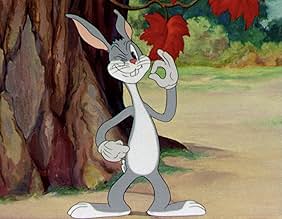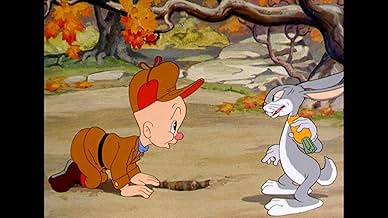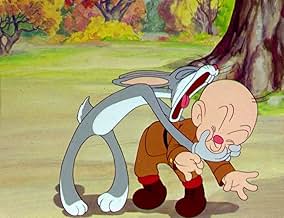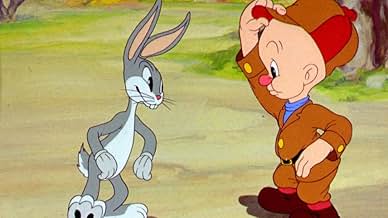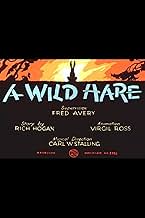Ajouter une intrigue dans votre langueWhile hunting rabbits, Elmer Fudd comes across Bugs Bunny, who tricks and harasses the hunter.While hunting rabbits, Elmer Fudd comes across Bugs Bunny, who tricks and harasses the hunter.While hunting rabbits, Elmer Fudd comes across Bugs Bunny, who tricks and harasses the hunter.
- Director
- Writer
- Stars
- Nommé pour 1 oscar
- 2 nominations au total
Mel Blanc
- Bugs Bunny
- (voice)
- (uncredited)
- …
Arthur Q. Bryan
- Elmer Fudd
- (voice)
- (uncredited)
Avis en vedette
One of the great landmarks in cinema history. After several false starts, Bugs Bunny is finally born
It's a classic set-up. A round-headed, bulbous-nosed hunter creeps through the woods brandishing his gun, briefly turning to the audience to inform them "Be vewwy, vewwy quiet, I'm hunting wabbits". Coming across a rabbit hole, the hunter begins to dig while from an adjacent hole a grey bunny emerges, casually moseys up to the hunter and, with a breathtaking confidence that suggests he sees the hunter as no threat whatsoever, asks "What's up, Doc?" And cinema history is changed forever.
Tex Avery's 'A Wild Hare' not only created a universal superstar in Bugs Bunny but also remains the quintessential Bugs cartoon to this day. Mention the name Bugs Bunny to anyone and 90% of them will immediately picture a rabbit hole in a forest and Elmer Fudd stalking towards it. Not only does 'A Wild Hare' open exactly this way, the first line is Elmer's most famous catchphrase. When Bugs puts in an appearance, his opening line is perhaps the most famous catchphrase of all time. So the scene is set, the template established for a rivalry that will continue for decades. There's enough history in the opening couple of minutes of 'A Wild Hare' to make any serious cartoon fan's heart swell with joy but there's plenty more to recommend it. While it may seem like a comparatively no-frills cartoon for those who grew up watching the many, many variations on this set-up that followed, keep in mind that this was Bugs's debut and these now familiar routines are being tried out for the first time. Bugs has rarely been cooler or looked more handsome than he does in 'A Wild Hare', his nonchalance really striking a chord with audiences and ensuring his place in cartoon history.
While there were a handful of cartoons that predate 'A Wild Hare' starring prototype Bugs Bunnys, Avery's cartoon is undoubtedly the first time he was the character we all know and love and, therefore, clearly his official debut. Avery's expert timing, Mel Blanc and Arthur Q. Bryan's instant chemistry as Bugs and Elmer and a solid script by Rich Hogan all contribute to creating an Academy Award nominated classic and the smell of history that now lingers around 'A Wild Hare' makes it positively electric. 'A Wild Hare' is an experience to treasure which, for me, will never lose its heart-stopping air of excitement.
Tex Avery's 'A Wild Hare' not only created a universal superstar in Bugs Bunny but also remains the quintessential Bugs cartoon to this day. Mention the name Bugs Bunny to anyone and 90% of them will immediately picture a rabbit hole in a forest and Elmer Fudd stalking towards it. Not only does 'A Wild Hare' open exactly this way, the first line is Elmer's most famous catchphrase. When Bugs puts in an appearance, his opening line is perhaps the most famous catchphrase of all time. So the scene is set, the template established for a rivalry that will continue for decades. There's enough history in the opening couple of minutes of 'A Wild Hare' to make any serious cartoon fan's heart swell with joy but there's plenty more to recommend it. While it may seem like a comparatively no-frills cartoon for those who grew up watching the many, many variations on this set-up that followed, keep in mind that this was Bugs's debut and these now familiar routines are being tried out for the first time. Bugs has rarely been cooler or looked more handsome than he does in 'A Wild Hare', his nonchalance really striking a chord with audiences and ensuring his place in cartoon history.
While there were a handful of cartoons that predate 'A Wild Hare' starring prototype Bugs Bunnys, Avery's cartoon is undoubtedly the first time he was the character we all know and love and, therefore, clearly his official debut. Avery's expert timing, Mel Blanc and Arthur Q. Bryan's instant chemistry as Bugs and Elmer and a solid script by Rich Hogan all contribute to creating an Academy Award nominated classic and the smell of history that now lingers around 'A Wild Hare' makes it positively electric. 'A Wild Hare' is an experience to treasure which, for me, will never lose its heart-stopping air of excitement.
Rabbits were common in early animation such as in Walt Disney's 'Oswald the Rabbit.' But the king of all cartoon rabbits is Bugs Bunny. His first official appearance was in July 1940 "A Wild Hare,' co-starring Elmer Fudd as the hunter entrapped by Bugs Bunny's clever antics.
The Merrie Melody cartoon, drawn by the wizard artists at Leon Schlesinger Productions, was part of Warner Brothers distribution arm. The studio had introduced an earlier incarnation of Bugs in 1938's "Porky's Hare Hunt' featuring a frustrated Porky the Pig trying to shoot a clever and elusive rabbit. Four cartoons later of the pesky rabbit Bugs appeared in "A Wild Hare," directed by Tex Avery. Voice actor Mel Blanc employed his Bronx/Brooklyn accent to mimic the rabbit modern viewers are familiar. This is the first cartoon Bugs uses his catchphrase, "What's up, Doc?" Director Tex Avery claims he's the one who came up with the phrase from his days living in Texas where it was a commonly said. Mel Blanc, however, said he first ad-libbed the saying spontaneously in the narration booth, and everyone loved it.
Animator Bob Givens was assigned to redesign the previous rabbits into the basic look we see today as Bugs Bunny. Givens lengthened the rabbit's body, and has him standing straight up. There were a couple of attributes as to the origins on Bugs' habit chomping on carrots. One is the famous scene in 1934's Academy Award Best Picture winner "It Happened One Night" where Clark Gable munches on a carrot while Claudette Colbert exhibits her method of hitchhiking. Another is wise-cracking actor Roscoe Karns' character Oscar Shapely in the same movie, who was a big carrot fan.
Bugs Bunny appeared in over 160 cartoons between 1940 and 1964, and has been in more films than any other animated character. Bugs has a star on Hollywood's Walk of Fame and is Warner Brothers' official mascot.
The Merrie Melody cartoon, drawn by the wizard artists at Leon Schlesinger Productions, was part of Warner Brothers distribution arm. The studio had introduced an earlier incarnation of Bugs in 1938's "Porky's Hare Hunt' featuring a frustrated Porky the Pig trying to shoot a clever and elusive rabbit. Four cartoons later of the pesky rabbit Bugs appeared in "A Wild Hare," directed by Tex Avery. Voice actor Mel Blanc employed his Bronx/Brooklyn accent to mimic the rabbit modern viewers are familiar. This is the first cartoon Bugs uses his catchphrase, "What's up, Doc?" Director Tex Avery claims he's the one who came up with the phrase from his days living in Texas where it was a commonly said. Mel Blanc, however, said he first ad-libbed the saying spontaneously in the narration booth, and everyone loved it.
Animator Bob Givens was assigned to redesign the previous rabbits into the basic look we see today as Bugs Bunny. Givens lengthened the rabbit's body, and has him standing straight up. There were a couple of attributes as to the origins on Bugs' habit chomping on carrots. One is the famous scene in 1934's Academy Award Best Picture winner "It Happened One Night" where Clark Gable munches on a carrot while Claudette Colbert exhibits her method of hitchhiking. Another is wise-cracking actor Roscoe Karns' character Oscar Shapely in the same movie, who was a big carrot fan.
Bugs Bunny appeared in over 160 cartoons between 1940 and 1964, and has been in more films than any other animated character. Bugs has a star on Hollywood's Walk of Fame and is Warner Brothers' official mascot.
. . . to describe The Academy's wrong-headed illogical contrarian decision to overlook A WILD HARE when it came time to recognize the best cartoon of 1940. Anyone can see at a glance that Bugs Bunny is hopping convoluted circles here around the thin plots favored by the wildly overrated Oswald. When it comes to bunniers, Bugs obvioiusly represents the Cat's Meow. Furthermore, we're not talking Jerry here. Though the latter gave rise to the phrase "jerry-rigged" for describing a supposedly honest ballot for which all concerned are well aware that "the fix is in," A WILD HARE stands so far above any of the crude animations of the Twenties and Thirties that it should have won any awards up for grabs totally uncontested, by unaminous consent..
This is my third favorite cartoon, only beat by Invasion of the Bunny Snatchers and Duck Amuck. It manages to feel newer than the shorts where Elmer is fat, due to having Elmer's final design. It also has value that makes this based, introducing Bugs.
It is very hard to review "A Wild Hare" on its own solo merit after the sixty-plus years that followed and thus turned its central character into the biggest cartoon character ever. In comparison to the subsequent films that appeared until 1964, this very first official entry is tame but still a wonderful model for those that followed.
Let's say this was 1940 and If I saw this cartoon for the first time ever with absolutely no knowledge of Bugs Bunny, I would say that "A Wild Hare" alone is a fine cartoon, in which the hunter becomes the heckled. The prey is a slick "wabbit" character that starts in on him at the very beginning, knocking on the wisping hunter's bald head to get his attention.
It is no wonder that this cartoon is directed by Fred Avery, who only three years ago directed a similar cartoon called "Porky's Duck Hunt," in which Porky's prey evolved into the current Looney Tunes star Daffy Duck. Should we be keeping our eyes on this "wabbit?"
Let's say this was 1940 and If I saw this cartoon for the first time ever with absolutely no knowledge of Bugs Bunny, I would say that "A Wild Hare" alone is a fine cartoon, in which the hunter becomes the heckled. The prey is a slick "wabbit" character that starts in on him at the very beginning, knocking on the wisping hunter's bald head to get his attention.
It is no wonder that this cartoon is directed by Fred Avery, who only three years ago directed a similar cartoon called "Porky's Duck Hunt," in which Porky's prey evolved into the current Looney Tunes star Daffy Duck. Should we be keeping our eyes on this "wabbit?"
Le saviez-vous
- AnecdotesThe producers' reaction to the gag of Bugs responding to a hunter pointing a gun at him with a confident casual remark, "What's up, Doc?" was so favorable that they decided to make that a standard element of future films featuring the character.
- GaffesAfter Bugs ties up Elmer's shotgun and Elmer throws it away he then starts digging. Bugs comes up from his other hole, saying his first time ever "Eh Whats up Doc?" then Elmer says "I am looking for a Wabbit". Bugs starts describing a rabbit and during a close up When Elmer realized Bugs is a rabbit he us holding the shotgun again, next panel it's gone again.
- Citations
[first lines]
Elmer Fudd: [first occurence of this line] Be vewy, vewy qwiet. I'm hunting wabbits.
- Générique farfeluIn the 1944 Blue Ribbon reissue of this cartoon, when the WB shield zooms in the copyright notice briefly says MCMXLIV(1944) for a fraction of a second before changing to MCMXL(1940)!
- Autres versionsWhen the cartoon was re-released as a Blue Ribbon re-issue, it was inadvertently retitled "The Wild Hare." Also, one of the names Elmer Fudd guesses was changed from Carole Lombard, who had recently died in a plane crash, to Barbara Stanwyck.
- ConnexionsEdited into Bugs Bunny Superstar (1975)
- Bandes originalesYankee Doodle
(ca. 1755) (uncredited)
Traditional music of English origin
Meilleurs choix
Connectez-vous pour évaluer et surveiller les recommandations personnalisées
- Which series is this from: Merrie Melodies or Looney Tunes?
- What four names does Elmer Fudd guess?
- List: Warner Bros. cartoons nominated for Academy Awards
Détails
- Durée8 minutes
- Mixage
- Rapport de forme
- 1.37 : 1
Contribuer à cette page
Suggérer une modification ou ajouter du contenu manquant


